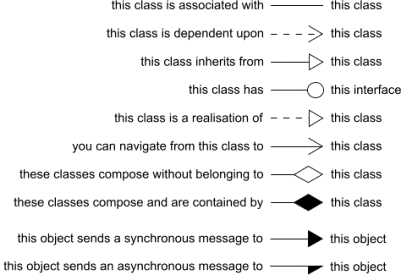
Dependency shows a supplier-client type of relationship. Changes to the parent class will also affect the child class. Dependencyĭependency arrows show us where two elements depend on each other, but in a less strong relationship than a basic association.

Make your own UML class diagram with Gleek. In gleek.io we create a composition arrow by typing two hyphens followed by a star inside a lesser-than and greater-than symbol. For example, a pocket on the front of a shirt cannot exist if we destroy the shirt. Composition associations show relationships where the sub-object exists only as long as the container class exists. The syntax looks like this: –Ĭomposition arrows show up in UML class diagrams when we want to show a similar association to aggregation, with a key difference. In gleek.io we create aggregation arrows by typing two hyphens followed by a lesser-than symbol followed by a greater-than symbol. For example, a book still exists if somebody checks it out from the library. The child class can exist independent of the parent element. We use aggregation arrows when we want to convey that two classes are associated, but not as close as in direct association. In gleek.io we create this association with two hyphens and a greater-than symbol. The bowl acts as a container class for the fruit class. We represent a direct association with an arrow pointing to our object class. Directed associationĭirected association shows a strong relationship between classes. There are several sub-types of association. In gleek.io we create this by typing two hyphens:. We show a simple association with a straight line.

For example, we show a direct link between a city bus and its riders using an association line. Association means any type of relationship or connection between classes. AssociationĪssociation is the most basic of relationships. Let’s take a closer look at the arrows and how they function in UML class diagrams. The arrows denote association, inheritance, aggregation, composition, dependency, and realization among others. The arrows that connect classes show important relationships. The UML class diagram maps out the object’s attributes, operations, and how they relate. What, exactly is the purpose of class diagram arrows? Developers use class diagrams to show different objects in a system. We can show all of this information in UML class diagrams by using class diagram arrows. Some of these relationships are stronger than others. Other times the one class might inherit the function of another class. Sometimes one class acts as a parent to another. So, what exactly are class diagram relationships? UML class diagram relationships show how one class affects another. We connect classes with arrows that show relationships between them. In UML classes appear in a rectangle with attributes and operations listed below. What are UML classes exactly? UML classes represent objects that have a common structure and behave in a similar way. Developers use UML class diagrams to view the structure of static systems.

UML diagrams map out the classes, attributes, operations, and relationships among objects in a system. UML stands for unified modeling language. UML class diagrams allow developers to graphically represent a system or program.


 0 kommentar(er)
0 kommentar(er)
